Our Services
Dento Alveolar Surgery
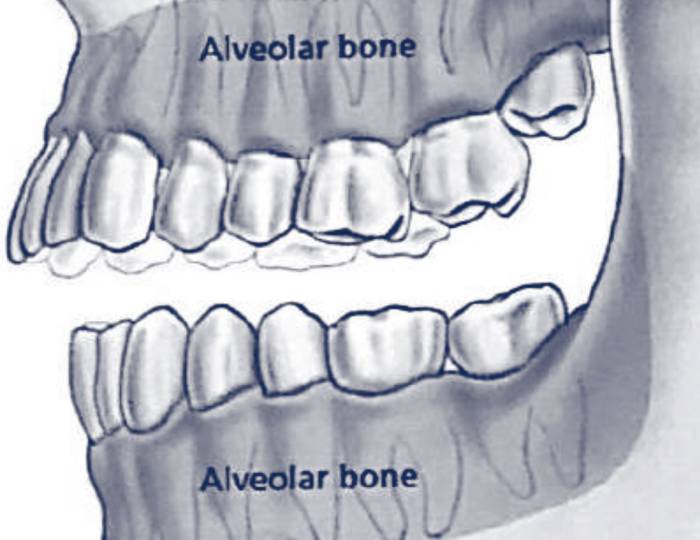
Some common surgical procedures include:
Extraction of a tooth or a retained root
Odontome removal
Exposure of a tooth
Freenectomy
Removal of cysts
Oral Pathology
Aid in root canal therapy
Aid in fitting of a prosthesis
The Principles Of Dento Alveolar Surgery
Some of the reasons to remove a tooth may be:
Impacted or mal-aligned teeth that may lead to problems in the future
Weakened, dead or symptomatic teeth
Failed root filling or extensive decay
Teeth affected by gum and bone disease
Prevention of complications such as infections
Removal of a retained root fragment of a tooth
Part of orthodontic treatment to create space for the orthodontist to align the teeth or to improve appearance of a smile
Removal of an extra (supernumary tooth)
Removal of a tooth that no longer has function
Unerupted teeth may become impacted and may require surgical exposure to help them erupt. Occasionally attachment of an orthodontic bracket may also be required to allow traction to be placed on the tooth to help erupt it.
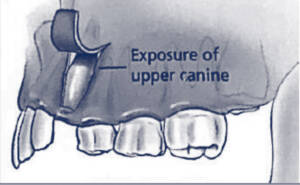
An odontoma is a primitive and malformed tooth. It can cause swellings, delay eruption or displace or affect the roots of adjacent teeth. An odontome should be removed whenever practicable.
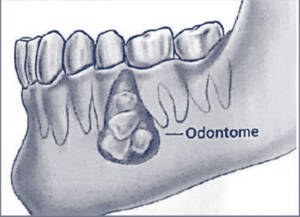
The upper lip is attached to the gums by a thin band of tissue called a “labial freenum”. Occasionally the freenum can be abnormally thick and cause a large gap between the front teeth.
The tongue is attached to the gums by a similar band of tissue called a “lingual freenum”. Occasionally this can limit movement of the tongue, swallowing or speech.
Removal of the freenum is called a frenectomy.
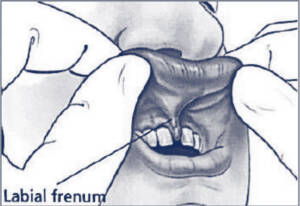
Cysts are fluid filled sacs that are slowly growing and can result in infection, pain and swelling. They can become large enough to affect nearby healthy teeth or strength of the jaws. Once diagnosed, they are best treated before symptoms arise or get worse. A tooth associated with the cyst may also need to be removed. Cysts can be treated by removal (enucleation) or opened with part of the lining removed (marsupialised).
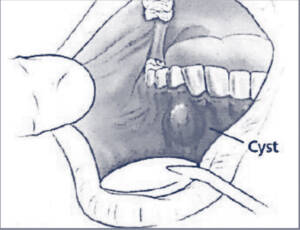
When a nerve and pulp tissue in a tooth dies, an abscess results at the tip of the root. An abscess can spread through the jawbone and cause severe illness. Surgery to remove the root tip, called an apicectomy, can clear the infection and potentially save the tooth. This needs to be done in conjunction with a root canal therapy performed by a dentist or endodontist.
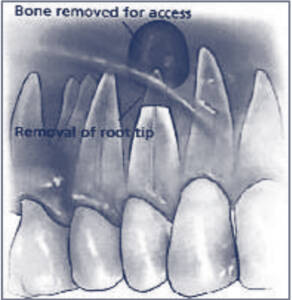
A comfortable and functional fit for dentures may sometimes require surgery on the dento-alveolar ridges. The aim of surgery is to remove excessive gum tissues, fibrous tissues, scars or a bony outgrowth (“torus”).
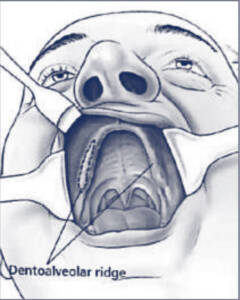
For any abnormal tissue in the mouth, the entire tissue or a small piece may need to be removed for assessment. This is called a biopsy. The biopsy specimen will be sent to a pathologist to assess whether it is non-cancerous (benign) or cancer (malignant). The pathologist will send a report to your surgeon, who will subsequently discuss this with you. Occasionally a second biopsy may be needed if the first biopsy has an uncertain result.
Possible Complications Of Dento-alveolar Surgery
As with any surgical procedure, dento alveolar surgery has risks despite the highest standards of practice. Your surgeon will make every attempt to minimise risk and complications.
It is not possible to outline every possible complication of dento alveolar surgery. However, it is important that you have enough information to weigh up the risks and benefits of the surgery.
The following complications are list to inform you however not to alarm you. Please feel free to discuss this with your surgeon.
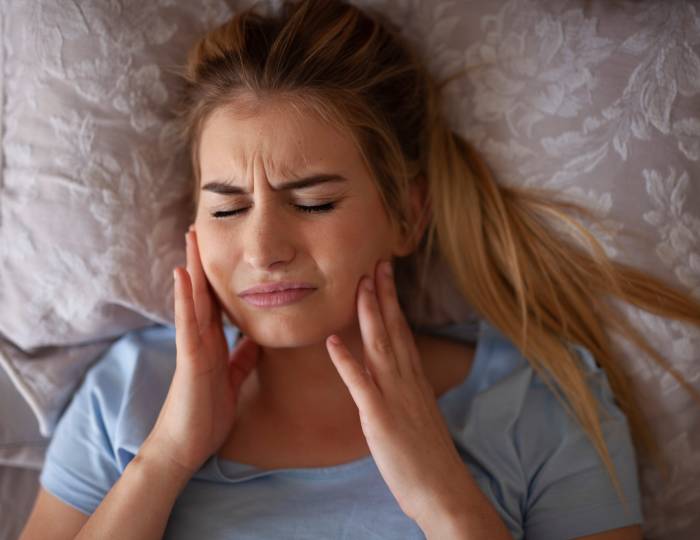
The area to be treated may be close to a nerve. On a very small number of occasions the nerve can be injured. If an injury occurs, the result may be numbness, tingling, “pins and needles” and rarely pain to the lower lip, gums, teeth and tongue. The injury usually heals and may take up to twelve months. Movement and position of the lips and tongue will not be affected.
Numbness of the lips and tongue may be a major factor that affects some people’s work or daily life. If this may be the case, please discuss this with your surgeon prior to surgery.
In a very small number of cases, nerve damage may heal poorly resulting in persisting pain. This can happen despite successful surgery and despite all care taken to prevent nerve injury. It is not known why this occurs in some people. Pain in these cases may need to be treated by long term medications and involvement of pain specialists. Please note, this is a rare phenomenon.
As with any surgery, there is a small chance of infection. Infection is treated with antibiotics. Very rarely and infection may need to be washed out if the antibiotic is not effective.
Difficulty in opening mouth (“Trismus”).
Difficulty in opening your mouth as a result of pain or trismus is normal. Thus, usually improves with one to two weeks.
Your body temperature will be elevated for one or two days after surgery. This is a normal response to surgery. A fever arising a few days after surgery may be an indication of infection. If you notice this, please contact your surgeon.
Slight ooze or spots of blood are expected in the first day or two. Excessive bleeding is rare. If you are concerned fold and place a piece of gauze at the site of surgery and bite on it for 30 minutes. DO NOT remove the gauze pack during this time.
During surgery pressure or stretch of your lips may be required. This may result in a bruise or small sores. These will heal without any issues. Lip sores are rare.
During dento alveolar surgery part of the adjacent tooth or filling may be chipped or loosened. This is rare.
When upper teeth are close to the sinuses an opening between the sinus and the mouth may occur following removal of the tooth. If the opening is large, your surgeon will fix this at the time of surgery. This usually heals without any issues. Occasionally a further procedure may be needed to close this opening.
After the removal of any tooth, the clot that forms over the bone can dissolve or wash away. This is termed dry socket. If this occurs, it results in a constant, throbbing pain lasting for a week or more. If you have such pain, contact your surgeon.
To help minimise the chance of dry socket:
Do not smoke until the surgical site has completely healed
Do not rinse your mouth in the first 24 hours
After the first 24 hours, rinse your mouth gently with the recommended mouth rinse
Try and keep the rest of your teeth as clean as possible. Be gentle around the area of surgery.
What To Expect
After Surgery
You will have a post-operative appointment made for you to check on your progress.
All patients have different recovery rates and different levels of pain tolerance. The following information is a guide to your expected recovery. If you have any concerns, please feel free to call Omsspecialists.
The following information is a guide to your expected recovery.
If you have any concerns, please feel free to call Newcastle Oral & Facial Surgery.
- Please organise someone to drive you home from hospital
- Rest from normal activities for 5 days
- Return to work approximately 1 week following your procedure
- Refrain from strenuous activities such as sports or exercise for 2 weeks
- DO NOT operate any heavy machinery or drive any vehicles for at least 72 hours after anaesthetic or if you are on sedative medications
Avoid foods that are too hot or too cold within the first 24 hours
Soft diet is recommended in the first 7-10 days
Make sure you drink plenty of fluids whilst you are on a soft diet. We recommend at least 2 litres of fluid per day
Your surgeon will advise you on the medications you have been prescribed
Any antibiotics prescribed should be taken until the course is completed
Analgesics (pain-killers) should be taken regularly for 5 days as per the instructions
Post-operative pain is expected with any surgery
Pain usually starts after 24 hours and peaks at 5-7 days after
Pain should start to subside after 10 days
Take analgesics (pain-killers) as prescribed
Slight red ooze is normal in the first 2 days
If you are concerned, fold and place a piece of gauze at the site of surgery and bite on it for 30 minutes. DO NOT remove the gauze pack during this time.
Rest lying flat with your head elevated
Place an icepack or ice wrapped in a towel over the side of your jaw
If the bleeding does not stop after 2-3 hours, please contact the clinic
DO NOT rinse your mouth in the first 24 hours
Rinse your mouth with the advised mouth rinse for 2-3 weeks
Brush your other teeth GENTLY and as best as possible
Ice packs held against the jaw and changed every 15 min for the first 12 hours can reduce swelling
Post-operative swelling (oedema) is expected after surgery
It usually peaks after 3 days and will gradually subside over the following 10 days
Restricted mouth opening (trismus) is expected for 2 weeks
After this period, we encourage mouth opening
It is normal to experience numbness to the lips, cheek, tongue and cheek
Take care not to bite your lips and tongue whilst still numb, especially in the first 24 hours
This should improve after 2 weeks
Stitches (sutures) used will dissolve unless advised by your surgeon
These usually dissolve in 3-4 weeks but may vary between patients
In case of any difficulty breathing, uncontrolled bleeding or any other emergency make your way immediately to your local hospital emergency department (ed).

